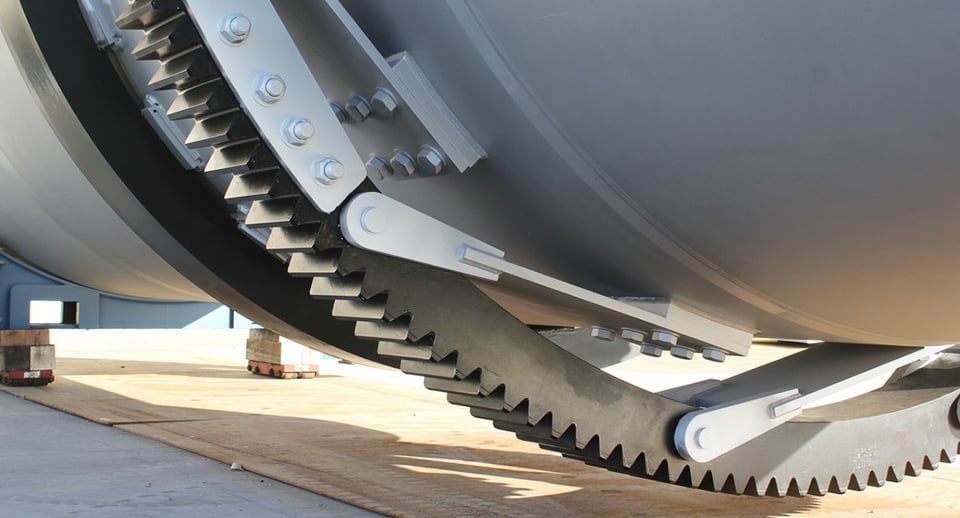When properly fabricated and maintained, a quality girth gear (also known as a ring gear) can last more than 25 years. However, proper lubrication, maintenance, and inspection are often overlooked, resulting in excess wear and damage to the gear.
As a principle structural and mechanical component, the girth gear has widespread effects when allowed to wear, risking potential damage and downtime in rotary dryers, kilns, and other rotary drum equipment. As a result, gear wear should be addressed immediately, typically through replacement, though in cases of onset wear, simple adjustments may prevent further damage.
Preventative replacement of a girth gear is significantly more cost-effective than addressing equipment failure later, particularly considering that girth gears can have a long lead time.
Available Gears
As a leading provider of custom rotary drum equipment, FEECO offers high-quality replacement girth gears in 4340 and 4140 carbon steel. Gears can be provided in sizes ranging from 60” to 180” in diameter, with face widths in excess of 25″.
As hardness of the girth and pinion gears plays an essential role in maximizing equipment life, gears are flame or induction hardened to achieve the required hardness.
FEECO gears are of the highest quality, following American Gear Manufacturers Association (AGMA) guidelines.
Indications That a Gear may Need Replacement
Gears can become worn for a number of reasons, including inadequate lubrication, misalignment, or the presence of tramp or fugitive material. Gears exhibiting worn or missing teeth or damaged gear mounting hardware should be replaced as soon as possible.
Wear and damage can be observed by examining the gear mesh – the way in which the girth gear and pinion gear come together at the point of joining. A worn gear may also exhibit unusual vibrations in the drive area, growling noises, or even wear patterns on the tires and trunnions.
Less obvious wear can be detected using a gear run-out, a technique that measures tooth height for the entire circumference of the drum as it rotates.
FEECO can perform an inspection to assess the mechanical condition of both girth and pinion gears as needed.
Girth Gear Installation & Replacement
Because improper installation could compromise the integrity of the girth gear and its service life, FEECO recommends girth gears be installed or replaced by a trained expert. FEECO can offer both installation/replacement and supervisory services.
The length of time required for gear replacement can vary based on a number of factors. In general, the average gear replacement takes between three and six days, with gear size and mounting style influencing the length of time required. Access to the drum can also influence how long the process takes.
Pinion Gear Replacement
FEECO recommends replacing the pinion gear at the same time as the girth gear. Not only does this avoid an additional shutdown for replacing the pinion gear in the future, but it prevents damage to the new girth gear that could otherwise be caused by pairing it with a worn pinion.
Gear-Mounting Replacement
Depending on the level of duty required and whether or not the drum is heated (i.e., a dryer or kiln), FEECO offers two different gear-mounting styles: Flange- and Spring-Mounted.
We recommend replacing all mounting hardware as part of the gear replacement process, but in some cases can accommodate the reuse of some hardware as needed. Because we recommend replacing all hardware, the need for gear replacement is a good time to reassess the mounting style.
Rotary Drum Alignment
It’s important to note that if gear damage was a result of trunnion misalignment, a realignment of the trunnions should be performed after gear replacement. This will ensure proper alignment of the mechanical components and prevent misalignment from causing wear to the new gear.
Contact our Customer Service Team for a quote on a replacement gear or other rotary drum parts. In addition to both girth and pinion gears, FEECO can also supply the complete drive assembly as needed.

